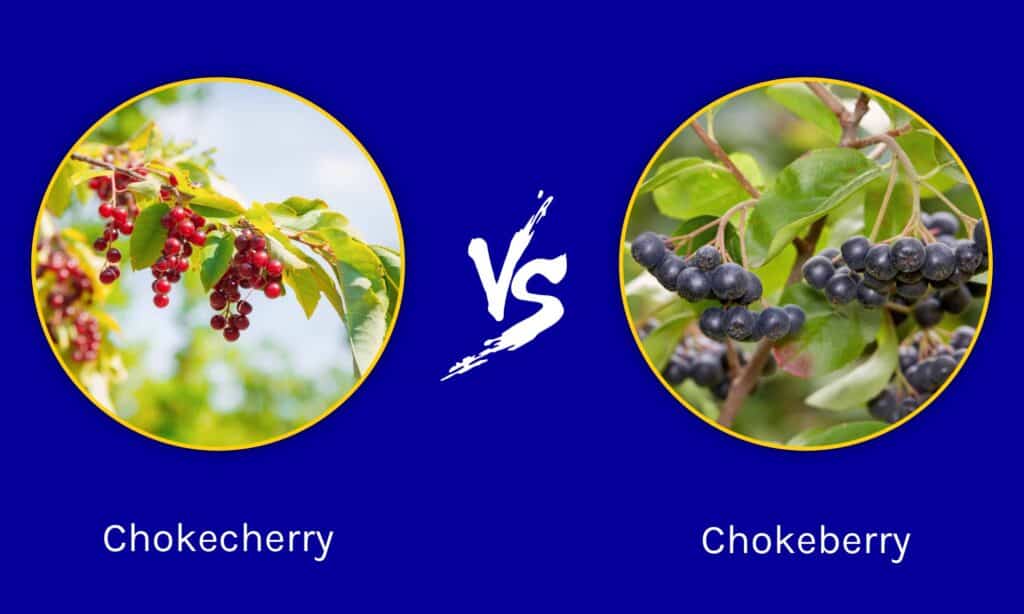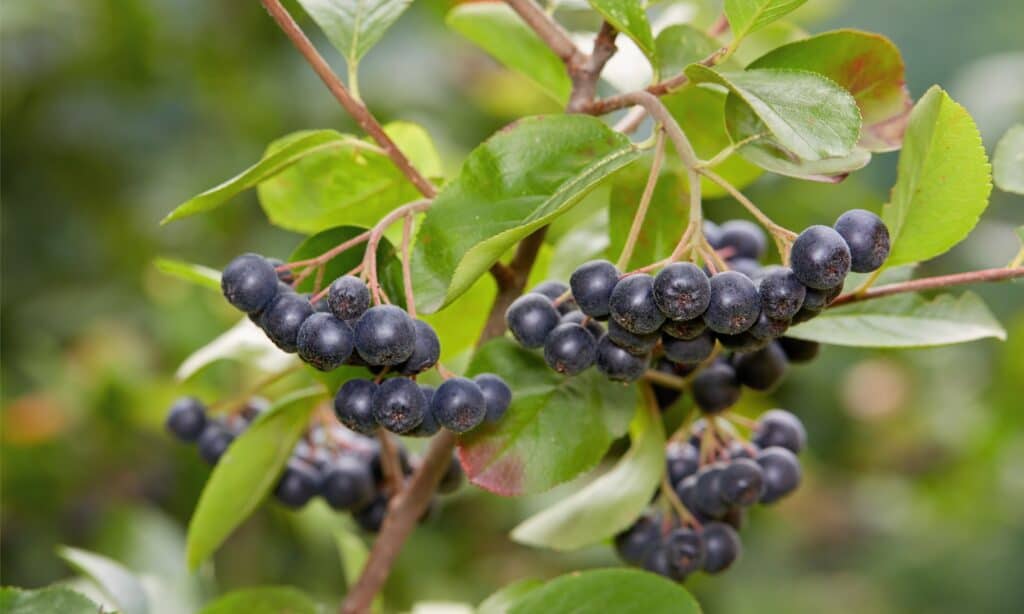Often mistaken for one another, are there any real differences between a chokecherry vs chokeberry? Given that these two plants are commonly grown throughout North America, you may have a hard time distinguishing them from one another. However, they are indeed two distinct species and only distantly related, so what separates chokecherries from chokeberries, and vice versa?
In this article, we will compare and contrast chokeberries with chokecherries so that you can fully understand the difference between them. We will go over what they look like as well as where they grow best in case you are interested in adding one of these plants to your backyard landscaping. Finally, we will talk about what these unique fruits and plants are used for nowadays. Let’s get started now!
Comparing Chokecherry vs Chokeberry

| Chokecherry | Chokeberry | |
|---|---|---|
| Plant Classification | Prunus virginiana | Aronia |
| Description | Reaches up to 30 feet tall but often grown as a shorter shrub. Leaves are oval shaped and green, and some varieties turn red with the seasons. Flowers grow in long tassels or racemes, typically white in color with yellow centers. Fruits are small and darken as they grow older, containing a large pit | Reaches up to 20 feet tall and typically grows shorter. Leaves are simple and green, typically turning red with the seasons. Flowers are white, simple, and clustered as individuals, with yellow centers and many stamens. Fruits are compact and without pits, and vary in color depending on the chokeberry variety (either purple, red, or black) |
| Uses | Key to the diets of Native Americans, as they consumed these berries frequently. The bark was also used medicinally, but nowadays it is used as an ornamental tree and occasionally has culinary uses | Popular ornamental plant, but also has a number of culinary uses. Made into wine and jams, as well as used as a juice concentrate for commercial juice productions. Sweeter than chokecherries overall |
| Origin and Growing Preferences | Native to most of North America; very hardy and doesn’t have many light or soil requirements. Grows best in zones 2-10 | Native to the eastern United States; grows well in the shade cast by larger trees. Very cold hardy and prefers hardiness zones 3-8 |
| Other Names | Bird cherry, bitter-berry, Virginia bird berry | Names based on the plant’s color, or simply aronia berries |
Key Differences Between Chokecherry vs Chokeberry

Chokeberries do not contain a large pit like chokecherries do.
©iStock.com/kazakovmaksim
There are a number of key differences between chokecherries and chokeberries. For example, chokeberries belong to a different plant genus from chokecherries. The average chokecherry plant grows taller than the average chokeberry plant. Chokeberries do not contain a pit, while chokecherries do. Finally, chokeberries are more commonly consumed worldwide given their sweeter flavor compared to the average chokecherry.
Let’s go over all of these differences in more detail now.
Chokecherry vs Chokeberry: Classification
While both chokecherries and chokeberries belong to the rose or Rosaceae family, they are distantly related and do not belong to the same plant genus as each other. For example, chokecherries belong to the Prunus plant genus, while chokeberries belong to the Aronia plant genus. This gives them some subtle but distinct differences from one another.
Chokecherry vs Chokeberry: Description

Chokeberry flowers grow in clusters or on their own, while chokecherry flowers grow in racemes or tassels.
©iStock.com/rparys
Despite them often being named interchangeably, there are some key differences in the descriptions of chokecherry plants and chokeberry plants. For example, the average chokecherry is taller than the average chokeberry, though both of these shrubs can be trained to grow as compact trees. In addition to this, chokeberry bushes change colors with the season, while not all chokecherry bushes do.
The leaves on both of these plants are very similar to each other but chokecherries have different flowers compared to chokeberries. For example, chokeberry flowers grow in clusters or on their own, while chokecherry flowers grow in racemes or tassels. When it comes to the fruits found on both of these plants, chokecherry fruits have large pits, while chokeberries do not. Chokecherry fruits also turn darker as they age, while chokeberry fruits come in different colors depending on the variety you choose. The most common chokeberry colors are red, purple, and black, while chokecherries turn a dark red as they age.
Chokecherry vs Chokeberry: Uses

Chokeberry fruits are sweeter compared to chokecherry fruits.
©iStock.com/gojak
Given that both of these plants produce an edible fruit, they have similar uses to each other. For example, the chokecherry was a key component in the diets of Native Americans throughout North America, while chokeberries have more culinary uses nowadays. Both of these plants are popular when used in an ornamental capacity in backyard landscaping, but chokeberry fruits are sweeter compared to chokecherry fruits on average, leading to more culinary uses overall.
Chokecherry vs Chokeberry: Origin and How to Grow
Chokecherries and chokeberries grow well in a variety of environments and conditions, considering they both originated in North America. However, the chokecherry is more widespread and its origin compared to the chokeberry, which originated in the eastern United States specifically. Chokecherry plants grow best in hardiness zones 2 through 10, while chokeberry plants grow best in zones 3 through 8. They are both cold tolerant and grow well in shade, making them perfect for planting underneath taller trees.
Chokecherry vs Chokeberry: Other Names

Chokecherry plants grow best in hardiness zones 2 through 10, while chokeberry plants grow best in zones 3 through 8.
©iStock.com/Elenakirey
The final difference between chokecherries and chokeberries lies in their names. They are often named interchangeably for each other, but they are indeed two separate plants. For example, chokecherry plants are also known as bird cherry, bitter-berry, or Virginia bird berry, while chokeberries are named depending on the color of their fruits. You can have red, purple, or black chokeberries, or you can simply refer to the entire plant as an aronia berry bush!
The photo featured at the top of this post is © iStock.com/Elenakirey
Sources
- Nutrient composition of selected traditional United States Northern plains native American plant foods, Available here: https://www.sciencedirect.com/science/article/pii/S0889157514000519
- Chokecherry in the Home Garden, Available here: https://extension.usu.edu/yardandgarden/research/chokecherry-in-the-garden
Thank you for reading! Have some feedback for us? Contact the AZ Animals editorial team.






